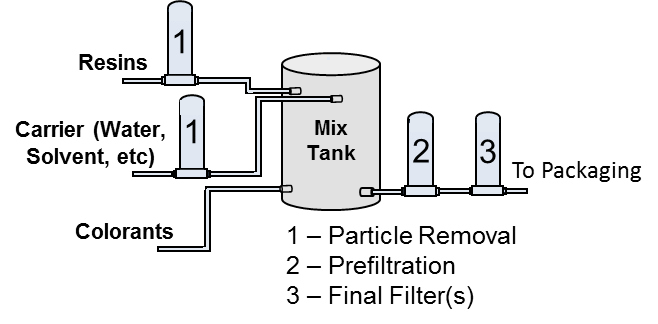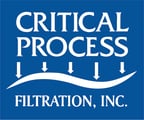For inkjet printing processes to work properly, regardless of the type of ink, unwanted particles must be removed from the ink. Particles can take any number of forms, from solids to agglomerated particles to gels.
All particles have the potential to clog ink jet print head openings and cause print defects.
The particle sizes can range from visible (usually larger than 40 microns) to sub-micron size. This paper focuses on removing larger, solid particles, which is usually done early in the process. Additional particle removal during a final filtration step is covered in another paper on final filtration for inkjet ink.
Particle Filters and Prefilters
Prefiltration is usually defined as the removal of particles larger than those targeted by the final filtration step. There can be multiple filtration steps to remove particles in stages so as not to overload a particular filtration step. The filters can be located anywhere in the process, but are usually found at the introduction of ingredients before final filtration and packaging.
The housings marked “1” and “2” in the Figure show two possible locations of particle removal filters and prefilters. Assuring that ink components (colorants and carrier) do not contribute particles to the beginning of the process is also a possible step, as is particle filtration and prefiltration after the mixing step. Though filter housing marked “2” is the only one shown for prefiltration in the schematic, multiple filters may be needed based on the filtration goal, type and quantity of particles in the stream at that point, and the size distribution of those particles. The goal of the prefilter is to protect the final filter (3).

The schematic in the figure is an example of a simplified ink jet ink formulation system. This simplified version shows one location for particle removal (housings marked “1”), just as raw materials are being supplied to the process, and a single prefiltration filter as housing “2”
Particles can certainly be introduced to the process with liquid ingredients such as dyes from outside sources. Though most liquid ingredients are concentrates and are usually not filtered, some operators may choose to use filters as a safeguard against premature clogging of final filters.
Considerations for Pigmented Inks
Pigments are solids added during the process. The solids are ground with pigment particles and impurities carried downstream further into the process. The biggest challenge in the filtration of pigmented inks is removing unwanted large particles while allowing most of the small particles to pass through the filters and be properly dispersed through the final product. The housings marked “2” and “3” in the schematic represent a two-step filtration system to control particles. Depth filtration is used for pigmented inks, but the selection of the specific filters is critical. The filtration results depend upon grind, dispersive agents, and the specific filters used. It is important to note that changing the grinding system may dramatically affect filter performance, resulting in excessive filter use and lower “small particle” yield. Contact Critical Process Filtration for assistance in evaluating filters that will work for your pigmented ink formulation.
Regardless of the type of ink produced, removing particles to levels required by your customers, no matter the source and no matter where it is done during product formulation is a critical process that protects downstream efficiency, protects the quality of your final product, and results in high-quality images for your customers.
Choosing the Right Particle Removal/Prefiltration Filters
Almost all particle removal filtration applications are done using depth filtration media. Cartridge filters use two forms of depth media. The standard depth filter is a self-supporting tube made using a polymer, most often polypropylene but also available in nylon. Standard depth filters take the form of a thick media tube made using the melt-blown or nano-spun process.
The other form of cartridge depth filter uses pleated flat sheet media, available in polypropylene or fiberglass. Polypropylene is the most widely used material for water and chemical filtration, but fiberglass has better filter efficiency and generally allows higher flows and throughput than polypropylene in prefiltration applications.
Standard depth filters will capture a range of particle sizes through the thickness of the media. Pleated media filters have the advantage of a large surface area that can hold a higher quantity of particles on that surface than standard depth filters.
Particle Filtration/Final Filter Options
Depth filtration products such as Critical Process Filtration Melt-Blown Polypropylene, Melt Blown Nylon, or Nano-Spun Polypropylene cartridges are commonly used for particulate removal. These products will remove a large number of particulates from a variety of product chemistries before requiring replacement.
If smaller particles need to be removed from the fluid stream, an economical alternative to standard depth filters is pleated media filters. Pleated filtration products, such as pleated polypropylene depth filters, have several times more surface area than melt-blown or nano-spun depth filters and will hold a much higher quantity of particles. Pleated filters do generally cost more, but the increased life in high-particle-load applications and savings from the reduced number of cartridges required for batch processes often make pleated filters economically advantageous.
Final Filters
The final filtration step in the ink jet ink formulation process is, as expected, the most critical one. The quality and value of the final product depend on the efficiency and cost-effectiveness of the filters chosen.
Of course, the objective is to remove all the particles and other contaminants that might adversely affect print quality. The amount of particle reduction and what needs to be removed can vary widely. For pigment-based inks, filters need to remove larger particles that can block ink jet ports but let smaller particles pass and assure that they are evenly dispersed in the ink. For some dye-based inks, removing undissolved particles or gels is the main goal, assuring that printheads remain clear and print quality is maintained.
The housing marked “3” in Figure 1 below is where “final” filtration is performed. This is just before packaging and is shown as a single-step process. However, formulators need to be aware of the type and number of particles in their products along with the size distribution of those particles. A very highly loaded stream may require multiple “final” filtration steps, even if the filtration goal is only the removal of larger particles.
In addition, if the goal is the removal of very small, sub-micron-sized particles or gels, operators will often use 2 or more stages of filtration to prevent premature fouling of the final filter. Using multiple filter steps often improves filtration process efficiency and cost-effectiveness.
The particles to be removed can be introduced to the process with ingredients from outside sources or even created as part of the process. Adding solid ingredients during the formulation may result in undissolved particles. Impurities can also be carried downstream and through the process. Particles can also be created by chemical reactions used in the formulation or from normal wear and tear on system components such as pumps and valves. The housing marked “3” is often protected by a prefilter (marked “2”) with a larger pore size rating. Prefiltration is discussed in a separate paper available from Critical Process Filtration.
Considerations for Pigmented Inks
The housing marked “3” represents the location of the final filter in this simplified system, though more than one filter may be used in series for inks with very high particle loads, like pigmented inks. The biggest challenge in the final filtration of pigmented inks is removing large particles while allowing most of the small particles to pass through the filters and remain evenly dispersed throughout the product. Depth filtration is the most often used technology, but the selection of the specific filters is critical. The filtration results depend upon grind, dispersive agents, and the specific filters used. It is important to note that different grinding systems dramatically affect filter performance, and may result in excessive filter use and lower “small particle” yield. Contact Critical Process Filtration for assistance in evaluating filters for your pigmented ink formulation.
Removing particles to levels required by your customers is a critical process that protects the quality of your final product and results in high-quality images for their clients.
Choosing the Right Final Filters
The decision on which filters to use for final filtration applications is based entirely on the types and sizes of particles or other contaminants to be removed. In dye-based inks, membrane filters are used as the final filter although a small number of manufacturers use glass fiber as the final filter. Membranes are the only way to assure that the smallest gels are removed and will eliminate any problems with ink jet orifices plugging. Also in dye-based inks, solid particles are not much of a problem because the carriers (water or solvents) are usually filtered before entering the process (such as with RO for water). Hard particles are usually easy to remove with the final filter without any clogging issues. In cases where a dye lot containing a high amount of gel material is received, depth filters are used as a prefilter (housing “2”) to extend the use of the membranes by removing the majority of gels.
For particles larger than 1 or 2 microns, depth filtration media is almost always used. Cartridge filters use two forms of depth media. The standard depth filter is a self-supporting, thick media tube made using a polymer, most often polypropylene but also available in nylon, which may have better compatibility with some inkjet ink chemistries. The other form of cartridge depth filter uses pleated flat sheet media, available in polypropylene or fiberglass. Polypropylene is the most widely used material for water and chemical filtration, but fiberglass has better filter efficiency and generally allows higher flows and throughput than polypropylene in many applications and may be chosen if fiberglass is compatible with the inkjet ink chemistry.
Standard depth filters will capture a range of particle sizes through the thickness of the media. Pleated media filters have the advantage of a large surface area that can hold a higher quantity of particles on that surface than standard depth filters.
For particles smaller than 1 micron, membrane filters are used. In almost all cases, the membrane filters will be used as part of a 2-step process. That filter will be protected by a filter with a larger pore size rating, which could be another membrane-based filter or a depth filter with a pore size rating only slightly above the final filter rating. The most cost-effective choices are usually determined by testing media combinations on a small scale.
Final Filter Options
Depth filtration products such as Critical Process Filtration Melt-Blown Polypropylene, Melt Blown Nylon, or Nano-Spun Polypropylene cartridges are commonly used for the removal of particles larger than about 2 microns. These products will remove a large number of particulates from a variety of product chemistries before requiring replacement.
Particles between 1 and 2 microns may be removed from the fluid stream using pleated media filters. Pleated filtration products, such as pleated polypropylene depth filters, have several times more surface area than melt-blown or nano-spun depth filters and will hold a much higher quantity of particles. While pleated filters do generally cost more, the increased life in high-particle-load applications and savings from the reduced number of cartridges used for batch processes often make pleated filters economically advantageous.
If sub-micron-sized particles or microorganisms need to be removed, membrane filters do so most efficiently. Membrane filters are often used in two-step filtration configurations with a prefilter protecting the membrane filter from excess particle loading
